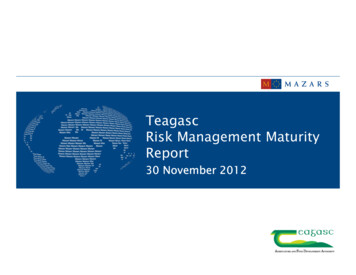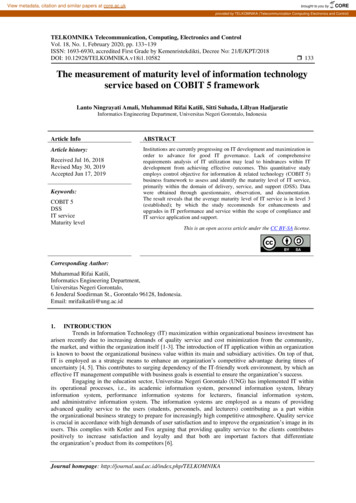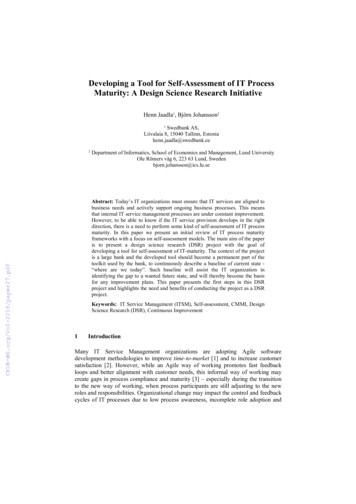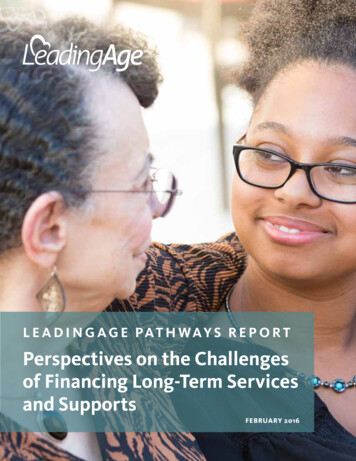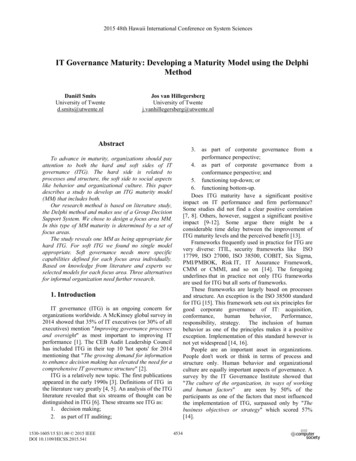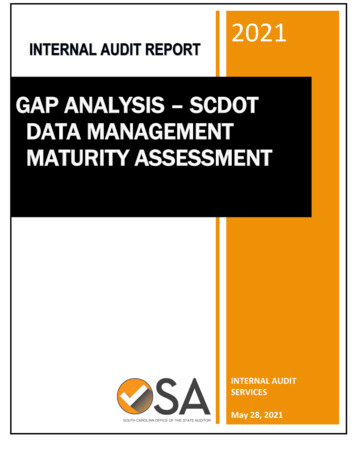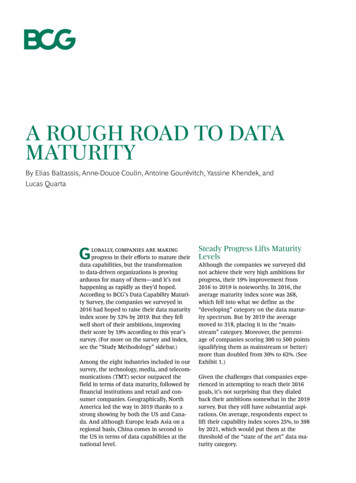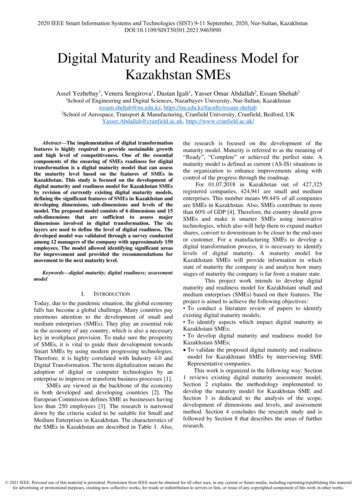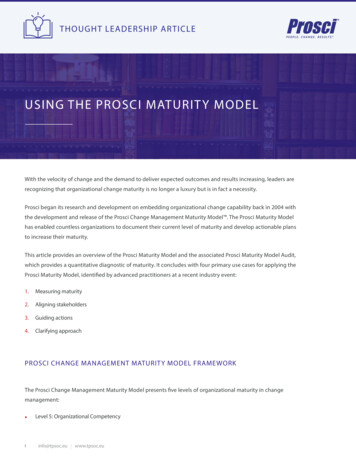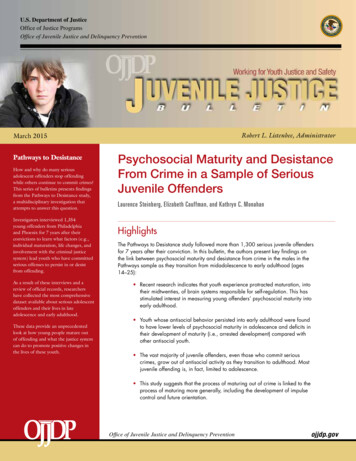
Transcription
U.S. Department of JusticeOffice of Justice ProgramsOffice of Juvenile Justice and Delinquency PreventionRobert L. Listenbee, AdministratorMarch 2015Pathways to DesistanceHow and why do many seriousadolescent offenders stop offendingwhile others continue to commit crimes?This series of bulletins presents findingsfrom the Pathways to Desistance study,a multidisciplinary investigation thatattempts to answer this question.Investigators interviewed 1,354young offenders from Philadelphiaand Phoenix for 7 years after theirconvictions to learn what factors (e.g.,individual maturation, life changes, andinvolvement with the criminal justicesystem) lead youth who have committedserious offenses to persist in or desistfrom offending.As a result of these interviews and areview of official records, researchershave collected the most comprehensivedataset available about serious adolescentoffenders and their lives in lateadolescence and early adulthood.These data provide an unprecedentedlook at how young people mature outof offending and what the justice systemcan do to promote positive changes inthe lives of these youth.Psychosocial Maturity and DesistanceFrom Crime in a Sample of SeriousJuvenile OffendersLaurence Steinberg, Elizabeth Cauffman, and Kathryn C. MonahanHighlightsThe Pathways to Desistance study followed more than 1,300 serious juvenile offendersfor 7 years after their conviction. In this bulletin, the authors present key findings onthe link between psychosocial maturity and desistance from crime in the males in thePathways sample as they transition from midadolescence to early adulthood (ages14–25): Recent research indicates that youth experience protracted maturation, intotheir midtwenties, of brain systems responsible for self-regulation. This hasstimulated interest in measuring young offenders’ psychosocial maturity intoearly adulthood. Youth whose antisocial behavior persisted into early adulthood were foundto have lower levels of psychosocial maturity in adolescence and deficits intheir development of maturity (i.e., arrested development) compared withother antisocial youth. The vast majority of juvenile offenders, even those who commit seriouscrimes, grow out of antisocial activity as they transition to adulthood. Mostjuvenile offending is, in fact, limited to adolescence. This study suggests that the process of maturing out of crime is linked to theprocess of maturing more generally, including the development of impulsecontrol and future orientation.Office of Juvenile Justice and Delinquency Preventionojjdp.gov
MARCH 2015Psychosocial Maturity and Desistance From Crime in aSample of Serious Juvenile OffendersLaurence Steinberg, Elizabeth Cauffman, and Kathryn C. MonahanInvolvement in delinquent and criminal behavior increasesthrough adolescence, peaking at about age 16 (in cases ofproperty crime) or age 17 (in cases of violent crime) anddeclining thereafter (Farrington, 1986; Piquero, 2007;Piquero et al., 2001). Although a small number of youthpersist in antisocial behavior across this developmentalperiod, the vast majority of antisocial adolescents desistfrom criminal behavior as they enter adulthood (Lauband Sampson, 2001; Piquero, 2007; Sampson and Laub,2003). Understanding why most juvenile offenders desistfrom antisocial activity as a part of the normative transitioninto adulthood may provide important insights into thedesign of interventions aimed at encouraging desistance.This bulletin describes findings from the Pathways toDesistance study, a multisite, longitudinal sample ofadolescent (primarily felony) offenders (see “About thePathways to Desistance Study”).1 This study explores theprocesses through which juvenile offenders desist fromcrime and delinquency.of adulthood leads individuals to adopt more conventionalvalues and attitudes.The conventional psychological view describes a differentscenario. According to this view, desistance from antisocialbehavior is the product of psychosocial maturation(Cauffman and Steinberg, 2000; Steinberg and Cauffman,1996; Monahan et al., 2009), which includes the abilityto: Control one’s impulses. Consider the implications of one’s actions on others. Delay gratification in the service of longer term goals. Resist the influences of peers.Theories of the PsychosocialMaturation ProcessThus, psychologists see that much juvenile offendingreflects psychological immaturity and, accordingly, theyview desistance from antisocial behavior as a naturalconsequence of growing up—emotionally, socially, andintellectually. As individuals become better able to regulatetheir behavior, they become less likely to engage inimpulsive, ill-considered acts.Both sociological and psychological theories suggest thatone reason most adolescents desist from crime is that theymature out of antisocial behavior, but sociologists andpsychologists have different ideas about the nature of thismaturation. A traditional sociological view is grounded inthe notion that the activities individuals typically enter intoduring early adulthood—such as full-time employment,marriage, and parenthood—are largely incompatiblewith criminal activity (Sampson and Laub, 2003). Thus,according to this view, individuals desist from antisocialbehavior as a consequence of taking on more maturesocial roles, either because the time and energy demandsof these activities make it difficult to maintain a criminallifestyle or because embracing the socially approved rolesAlthough the sociological and psychological explanationsof desistance from antisocial behavior during the transitionto adulthood are not incompatible, there has been muchmore research in the sociological tradition, largely becausepsychological maturation during young adulthood hasreceived relatively little attention from psychologists.Indeed, most research on psychological developmentduring adolescence has focused on the first half of theadolescent decade rather than on the transition fromadolescence to adulthood (Institute of Medicine, 2013),perhaps because social scientists widely assumed that therewas little systematic development after midadolescence(Steinberg, 2014). However, recent research indicatingprotracted maturation (into the midtwenties) of brain2Juvenile Justice Bulletin
systems responsible for self-regulation has stimulatedinterest in charting the course of psychosocial maturitybeyond adolescence (Steinberg, 2010). Because juvenileoffending is likely to wane during late adolescence andyoung adulthood (age 16 through age 25), it is importantto ask whether desistance from crime and delinquency islinked to normative processes of psychological maturation.Psychologist Terrie Moffitt (1993, 2003) has advancedthe most widely cited theory regarding psychologicalcontributors to desistance from antisocial behaviorduring the transition to adulthood. She distinguishedbetween the vast majority of individuals (90 percentor more, depending on the study) whose antisocialbehavior stopped in adolescence (adolescence-limitedoffenders) and the small proportion of individuals whoseantisocial behavior persisted into adulthood (life-coursepersistent offenders). Moffitt suggested that differentetiological factors explained these groups’ involvement inantisocial behavior. Moffitt hypothesizes that adolescencelimited offenders’ involvement in antisocial behavior isa normative consequence of their desire to feel moremature, and their antisocial activity is often the result ofpeer pressure or the emulation of higher status agemates,especially during midadolescence, when opposition toadult authority may confer special prestige with peers.In contrast, she thinks that antisocial behavior thatpersists into adulthood is rooted in early neurological andcognitive deficits that, combined with environmental risk,lead to early conduct problems and lifelong antisocialbehavior. Although the identification of variations in thesebroad patterns of antisocial behavior has led Moffitt torefine her framework (Moffitt, 2006; Moffitt et al., 2002),the scientific consensus is that the distinction betweenadolescence-limited and life-course persistent offenders is auseful one.Although Moffitt never explicitly outlined the role ofnormative psychosocial maturation in her framework, itfollows from this perspective that growth in psychosocialmaturity underlies adolescence-limited offenders’desistance from antisocial behavior. That is, if adolescencelimited offenders engage in antisocial behavior to appearand feel more mature, the genuine process of maturationshould lessen their need to engage in antisocial behavior toachieve this end, thereby contributing to desistance fromcrime and delinquency. Moreover, juvenile offenders whoare relatively more mature for their age, or who maturefaster than their peers, should “age out” of offendingsooner than others. Indeed, there is some evidence tosuggest that this is the case. In a previous analysis of earlierwaves of data from the Pathways study, the researchersfound that youth whose antisocial behavior persisted intotheir early twenties were significantly less psychosociallymature than youth who desisted from antisocial behavior(Monahan et al., 2009). In this bulletin, the researchersexplore whether this pattern characterizes trajectories ofantisocial behavior through age 25.Models of Psychosocial MaturityMany psychologists have proposed theoretical models ofpsychosocial maturity (e.g., Greenberger et al., 1974).The researchers’ approach to measuring psychosocialmaturity is based on a model advanced in the 1990s(Steinberg and Cauffman, 1996), which suggested thatduring adolescence and early adulthood, three aspects ofpsychosocial maturity develop: Temperance. The ability to control impulses, includingaggressive impulses. Perspective. The ability to consider other points ofview, including those that take into account longer termconsequences or that take the vantage point of others. Responsibility. The ability to take personalresponsibility for one’s behavior and resist the coerciveinfluences of others.Previous studies have demonstrated that youth with lowertemperance, perspective, and responsibility report greaterantisocial behavior (Cauffman and Steinberg, 2000) andthat, over time, deficiencies in developing these aspectsof psychosocial maturity are associated with more chronicpatterns of antisocial behavior (Monahan et al., 2009).The researchers’ model of psychosocial maturation mapsnicely onto one of the most widely cited criminologicaltheories of antisocial behavior: Gottfredson and Hirschi’s(1990) General Theory of Crime, which posits thatdeficits in self-control are the cause of criminal behavior.Gottfredson and Hirschi’s definition of self-control, likethe definition of maturity, includes components such asorientation toward the future (rather than immediategratification), planning ahead (rather than impulsivedecisionmaking), physical restraint (rather than theuse of aggression when frustrated), and concern forothers (rather than self-centered or indifferent behavior)(Gottfredson and Hirschi, 1990). Although the GeneralTheory of Crime is useful in explaining which adolescentsare more likely to engage in antisocial behavior (i.e., theones with poor self-control), it does not explain why mostantisocial adolescents desist as they mature into adulthood.From a developmental perspective, it may be variabilityin both individuals’ level of maturity during adolescenceand their degree of change in maturity over time thatdistinguishes between those whose antisocial behaviorwanes and those whose antisocial behavior persists duringthe transition to adulthood. The General Theory of Crimepredicts that, at any point in time, individuals who are lessmature than their peers would be more likely to engageJuvenile Justice Bulletin3
ABOUT THE PATHWAYS TO DESISTANCE STUDYThe Pathways to Desistance study is a multidisciplinary,multisite longitudinal investigation of how serious juvenileoffenders make the transition from adolescence to adulthood.It follows 1,354 young offenders from Philadelphia County, PA,and Maricopa County, AZ (metropolitan Phoenix), for 7 yearsafter their court involvement. This study has collected themost comprehensive dataset currently available about seriousadolescent offenders and their lives in late adolescence andearly adulthood. It looks at the factors that lead youth whohave committed serious offenses to persist in or desist fromoffending. Among the aims of the study are to: Identify initial patterns of how serious adolescentoffenders stop antisocial activity. Describe the role of social context and developmentalchanges in promoting these positive changes. Compare the effects of sanctions and interventions inpromoting these changes.Characteristics of Study ParticipantsEnrollment took place between November 2000 and March2003, and the research team concluded data collection in2010. In general, participating youth were at least 14 yearsold and younger than 18 years old at the time of their studyindex petition; 8 youth were 13 years old, and 16 youth wereolder than age 18 but younger than age 19 at the time of theirindex petition. The youth in the sample were adjudicateddelinquent or found guilty of a serious (overwhelmingly felonylevel) violent crime, property offense, or drug offense at theircurrent court appearance. Although felony drug offenses areamong the eligible charges, the study limited the proportionof male drug offenders to no more than 15 percent; this limitensures a heterogeneous sample of serious offenders. Becauseinvestigators wanted to include a large enough sample of femaleoffenders—a group neglected in previous research—this limitdid not apply to female drug offenders. In addition, youth whosecases were considered for trial in the adult criminal justicesystem were enrolled regardless of the offense committed.At the time of enrollment, participants were an average of16.2 years old. The sample is 84 percent male and 80 percentminority (41 percent black, 34 percent Hispanic, and 5 percentAmerican Indian/other). For approximately one-quarter (25.5percent) of study participants, the study index petition wastheir first petition to court. Of the remaining participants (thosewith a petition before the study index petition), 69 percenthad 2 or more prior petitions; the average was 3 in MaricopaCounty and 2.8 in Philadelphia County (exclusive of thestudy index offense). At both sites, more than 40 percent ofthe adolescents enrolled were adjudicated of felony crimesagainst persons (i.e., murder, robbery, aggravated assault,sex offenses, and kidnapping). At the time of the baseline4Juvenile Justice Bulletininterview for the study, 50 percent of these adolescentswere in an institutional setting (usually a residential treatmentcenter); during the 7 years after study enrollment, 87 percentof the sample spent some time in an institutional setting.Interview MethodologyImmediately after enrollment, researchers conducted astructured 4-hour baseline interview (in two sessions)with each adolescent. This interview included a thoroughassessment of the adolescent’s self-reported socialbackground, developmental history, psychologicalfunctioning, psychosocial maturity, attitudes about illegalbehavior, intelligence, school achievement and engagement,work experience, mental health, current and previoussubstance use and abuse, family and peer relationships, useof social services, and antisocial behavior.After the baseline interview, researchers interviewed studyparticipants every 6 months for the first 3 years and annuallythereafter. At each followup interview, researchers gatheredinformation on the adolescent’s self-reported behavior andexperiences during the previous 6-month or 1-year reportingperiod, including any illegal activity, drug or alcohol use, andinvolvement with treatment or other services. Youth’s selfreports about illegal activities included information aboutthe range, the number, and other circumstances of thoseactivities (e.g., whether or not others took part). In addition,the followup interviews collected a wide range of informationabout changes in life situations (e.g., living arrangements,employment), developmental factors (e.g., likelihood ofthinking about and planning for the future, relationshipswith parents), and functional capacities (e.g., mental healthsymptoms).Researchers also asked participants to report monthly aboutcertain variables (e.g., school attendance, work performance,and involvement in interventions and sanctions) to maximizethe amount of information obtained and to detect activitycycles shorter than the reporting period.In addition to the interviews of study participants, for the first3 years of the study, researchers annually interviewed a familymember or friend about the study participant to validate theparticipants’ responses. Each year, researchers also reviewedofficial records (local juvenile and adult court records and FBInationwide arrest records) for each adolescent.Investigators have now completed the last (84-month) setof followup interviews, and the research team is analyzinginterview data. The study maintained the adolescents’participation throughout the project: At each followupinterview point, researchers found and interviewedapproximately 90 percent of the enrolled sample. Researchershave completed more than 21,000 interviews in all.
in antisocial behavior. In this bulletin, the researchersexamine this proposition but also ask whether individualswho mature more quickly over time compared to theirpeers are more likely to desist from crime as they get older.working at difficult, boring tasks if I know they will helpme get ahead later”) (Cauffman and Woolard, 1999).To investigate whether and to what extent changes inpsychosocial maturity across adolescence and youngadulthood account for desistance from antisocial behavior,it is necessary to study a sample of individuals whoare known to be involved in antisocial behavior. ThePathways study affords an ideal opportunity to do thisbecause it is the first longitudinal study that examinedpsychosocial development among serious adolescentoffenders during their transition to adulthood. As a result,the researchers examined whether the majority of juvenileoffenders demonstrate significant growth in psychosocialmaturity over time, as the psychological theories ofdesistance predict, and whether individual variability inthe development of psychosocial maturity accounts forvariability in patterns of desistance. They also examinedwhether differential development of psychosocial maturityover time is linked to differential timing in desistance;presumably, those who mature faster should desist earlier.Because individuals generally cease criminal activity bytheir midtwenties (Piquero, 2007), this extension of aprevious analysis through age 25 allows greater confidencein any conclusions drawn about the connection betweenpsychosocial maturation and desistance from antisocialbehavior.The measures were self-reported personal responsibility(e.g., “If something more interesting comes along, I willusually stop any work I’m doing,” reverse scored) fromthe Psychosocial Maturity Inventory (Greenberger etal., 1974), and resistance to peer influence (e.g., “Somepeople go along with their friends just to keep their friendshappy, but other people refuse to go along with what theirfriends want to do, even though they know it will maketheir friends unhappy”) (Steinberg and Monahan, 2007).Measuring Psychosocial MaturityAs noted earlier, in the researchers’ theoretical model,psychosocial maturity consists of three separatecomponents: temperance, perspective, and responsibility(Steinberg and Cauffman, 1996). Each of thesecomponents was indexed by two different measures.For more detail on the psychometric properties of themeasures, see Monahan and colleagues (2009).TemperanceThe measures were self-reported impulse control (e.g.,“I say the first thing that comes into my mind withoutthinking enough about it”) and suppression of aggression(e.g., “People who get me angry better watch out”), bothof which are subscales of the Weinberger AdjustmentInventory (Weinberger and Schwartz, 1990).PerspectiveThe measures were self-reported consideration of others(e.g., “Doing things to help other people is moreimportant to me than almost anything else,” also fromthe Weinberger Adjustment Inventory; Weinberger andSchwartz, 1990) and future orientation (e.g., “I will keepResponsibilityIn addition to examining each indicator of psychosocialmaturity independently, the researchers also standardizedeach measure across the age distribution and thencalculated the average to create a global measure ofpsychosocial maturity.Measuring Antisocial BehaviorInvolvement in antisocial behavior was assessed using theSelf-Report of Offending, a widely used instrument indelinquency research (Huizinga, Esbensen, and Weihar,1991). Participants reported if they had been involvedin any of 22 aggressive or income-generating antisocialacts (e.g., taking something from another person byforce, using a weapon, carrying a weapon, stealing a caror motorcycle to keep or sell, or using checks or creditcards illegally). At the baseline interview and the 48through 84-month annual interviews, these questionswere asked with the qualifying phrase, “In the past 12months have you ?” At the 6- through 36-monthbiannual interviews, these questions were asked withthe qualifying phrase, “In the past 6 months, have you ?” The researchers counted the number of differenttypes of antisocial acts that an individual reported havingcommitted since the previous interview to derive themeasure of antisocial activity. So-called “variety scores”2are widely used in criminological research because they arehighly correlated with measures of seriousness of antisocialbehavior yet are less prone to recall errors than selfreported frequency scores, especially when the antisocialact is committed frequently (such as selling drugs). In thePathways sample, self-reported variety scores also weresignificantly correlated with official arrest records (Brameet al., 2004).Identifying Trajectories ofAntisocial BehaviorThe first task was to see whether individuals followeddifferent patterns of antisocial behavior over time. TheJuvenile Justice Bulletin5
Several points about these patterns are noteworthy: As expected—and consistent with other studies—thevast majority of serious juvenile offenders desisted fromantisocial activity by the time they were in their earlytwenties. Less than 10 percent of the sample couldbe characterized as chronic offenders. This statistic issimilar to that reported in other studies.research team used a type of analysis called group-basedtrajectory modeling (Nagin, 2005; Nagin and Land,1993) to determine whether they could reliably dividethe participants into distinct subgroups, each composedof individuals who demonstrated a common pattern ofantisocial behavior. This analysis indicated that there werefive different patterns, which are shown in figure 1. More than one-third of the sample were infrequentoffenders for the entire 7-year study period. Althoughall of these individuals were arrested for a very seriouscrime during midadolescence, their antisocial behaviordid not continue.The first group (low, 37.2 percent of the sample) consisted ofindividuals who reported low levels of offending at every timepoint. The second group (moderate, 13.5 percent) showedconsistently moderate levels of antisocial behavior. The thirdgroup (early desisters, 31.3 percent) engaged in high levelsof antisocial behavior in early adolescence, but their antisocialbehavior declined steadily and rapidly thereafter. The fourthgroup (late desisters, 10.5 percent) engaged in high levels ofantisocial behavior through midadolescence, which peakedat about age 15 and then declined during the transitionto adulthood. The fifth group (persistent offenders,7.5 percent) reported high levels of antisocial behaviorconsistently from ages 14 to 25. Even among the subgroup of juveniles who werehigh-frequency offenders at the beginning of the study(about 40 percent of the sample), the majority stoppedoffending by the time they reached young adulthood.Indeed, at age 25, most of the individuals who hadbeen high-frequency offenders when they were inmidadolescence were no longer committing crimes.This, too, is consistent with previous research showingthat very few individuals—even those with a historyof involvement in serious crime—were engaging incriminal activity after their midtwenties.Patterns of Change inPsychosocial MaturityOver TimeFigure 1. Five Trajectories of Antisocial BehaviorNumber of Antisocial le Justice BulletinModerateEarly DesistersLate DesistersPersistersThe researchers next examined patternsof change in psychosocial maturity. Wasadolescence a time of psychosocial maturationfor these juveniles? Was it a period ofcontinued growth in temperance, perspective,and responsibility? To answer these questions,they used an approach called growth curvemodeling. This statistical technique examineswhether, on average, individuals matured overthe course of the study and whether therewas significant variability within the sample
“As expected—and consistent with other studies—the vast majorityof serious juvenile offenders desisted from antisocial activityby the time they were in their early twenties.”in the level, degree, and rate of change in psychosocialmaturation.development continues beyond adolescence. This findingis consistent with new research on brain development,which shows that there is continued maturation of brainsystems that support self-regulation—well into themidtwenties. It is important to note that this pattern ofgrowth was seen in a sample of serious juvenile offenders,a population that is often portrayed as “deviant.”Across each of the six individual indicators of psychosocialmaturity—impulse control, suppression of aggression,consideration of others, future orientation, personalresponsibility, and resistance to peer influence—and theglobal index of psychosocial maturity, the pattern of resultswas identical. Individuals showed increases in all aspects ofpsychosocial maturity over time, but the rate of increaseslowed in early adulthood.Although these analyses indicate that, on average,adolescence and (to a lesser extent) early adulthoodare times of psychosocial maturation, the analyses alsoindicated—not surprisingly—that individuals differ in theirlevel of psychosocial maturity (i.e., some are more maturethan others of the same chronological age) and in the waythey develop psychosocial maturity during adolescence andearly adulthood (i.e., some mature to a greater degree orfaster than others) (see Monahan et al., 2009, for a fullerdiscussion). These results confirm that the populationof juvenile offenders—even serious offenders—is quiteheterogeneous, at least with respect to their psychosocialmaturation. This variability also leads to the question ofwhether differences in patterns of offending are linked todifferences in patterns of psychosocial development.Figure 2 illustrates this pattern; it shows the growthcurve for the composite psychosocial maturity variableand steady psychosocial maturation from age 14 to aboutage 22, and then maturation begins to slow down. Theresearchers investigated whether psychosocial maturationactually stopped by the end of adolescence and found thatit did not. Rather, they found that, across each of the sixindicators of psychosocial maturity and the global measureof psychosocial maturity, individuals in the Pathwayssample were still maturing psychosocially at age 25. Atthis age, individuals in the sample continued to increase inimpulse control, suppression of aggression, considerationof others, future orientation, personal responsibility, andresistance to peer influence—indicating that psychosocialPsychosocial Maturationand Patterns of OffendingFigure 2. Rates of Psychosocial Maturity Across Adolescenceand Early Adulthood1.0Rate of 425If it is true that desistance from crimeduring the transition to adulthoodis due, at least in part, to normativepsychosocial maturation, then thereshould be a connection between patternsof offending and patterns of psychosocialgrowth. Juvenile offenders vary in theirpatterns of offending and their patternsof psychosocial development. Are thetwo connected? More specifically, ispsychosocial maturation linked todesistance from antisocial behavior? Toexplore this question, the researcherscompared patterns of development inpsychosocial maturity within each of theJuvenile Justice Bulletin7
antisocial trajectory groups (figure 3). They selected age16, the average age of participants when first enrolled inthe study, to compare analyses that examined absolutelevels of maturity with those that examined changesin maturity over time across the entire age range (ages14–25).during adolescence showed significantly greater growthin psychosocial maturity than those who persisted intoadulthood.These findings are important for several reasons: Even in a population of serious juvenile offenders, therewere significant gains in psychosocial maturity duringadolescence and early adulthood. Between ages 14 and25, youth continue to develop an increasing abilityto control impulses, suppress aggression, considerthe impact of their behavior on others, consider thefuture consequences of their behavior, take personalresponsibility for their actions, and resist the influenceof peers. Psychosocial development is far from over atage 18.As hypothesized, individuals in different antisocialtrajectory groups differed in their absolute levels ofpsychosocial maturity and the extent to which theirpsychosocial maturity increased with age. The pattern ofgroup differences was similar for the different psychosocialmaturity subscales
crime and delinquency. Theories of the Psychosocial . Maturation Process. Both sociological and psychological theories suggest that one reason most adolescents desist from crime is that they . mature out of antisocial behavior, but sociologists and psychologists have different ideas about the nature of this maturation.

